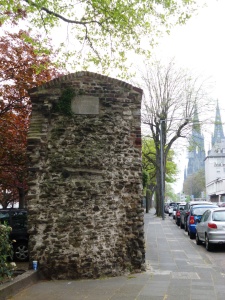Im Herzen von Köln (St. Andreas)
Vorm Fenster herrscht
der alte Dom
und unterm Fuß
das alte Rom.
Minutentakt
Der Boden bebt,
die U-Bahn pulst,
die Erde lebt.
Die Straße dröhnt,
die Weltstadt wacht,
der Domplatz zittert
Tag und Nacht.
Der Baulärm grellt,
das Blaulicht greint,
die Flöte lockt,
die Geige weint.
Die Orgel jauchzt,
die Glocke braust,
die Stille ruft,
die Stille rauscht.
Am Kreuz hängt einer
ganz allein
und will das Herz
der Erde sein.
Die heilge Stadt
lebt noch aus ihm.
Sie weiß es kaum;
er gibt sich hin.
Minutentakt:
Der Tunnel braust,
der Erdschlund grollt,
die U-Bahn saust.
O Einsamkeiten –
Mein Herz brennt.
O eigne Sehnsucht –
Mein Herz rennt.
Doch Ruhe ist ja
nur in Ihm…
So knie ich nieder:
Nimm mich hin.
Christina Egan ©1992
The first poem of the year takes place in Roman streets again, in the midst of Cologne, in Sankt Andreas, the mighty mediaeval church right opposite the Cathedral. When you descend into the crypt, you are pretty close to antiquity. All around, Roman walls are displayed, or simply still standing.
For an English poem about Cologne with a similar content and in a similar style, see My City Calls (Grey Roofs Grey Walls). There, it is the city itself which provides comfort and hope, as religious faith does here. I noticed the striking parallel only yesterday on relaunching my poetry blog!




